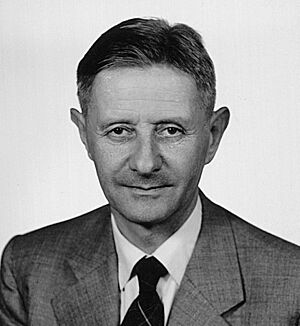Heinz Hopf facts for kids
Quick facts for kids
Heinz Hopf
|
|
|---|---|

Hopf in 1954
|
|
| Born | 19 November 1894 Gräbschen, Silesia, Prussia, German Empire
|
| Died | 3 June 1971 (aged 76) |
| Alma mater | University of Berlin |
| Known for | Almost complex manifold H-space Hopf algebra Hopf conjecture Hopf fibration Hopf invariant Hopf link Hopf manifold Hopf surface Hopf theorem Hopf's integral formula Hopfion Hopf–Rinow theorem Freudenthal-Hopf theorems Killing–Hopf theorem Poincaré–Hopf theorem Grid cell topology Spherical space form conjecture Sphere theorem |
| Scientific career | |
| Fields | Mathematics |
| Institutions | ETH Zürich |
| Thesis | Über Zusammmenhänge zwischen Topologie und Metrik von Mannigfaltigkeiten (1925) |
| Doctoral advisor | Erhard Schmidt Ludwig Bieberbach |
| Doctoral students | Beno Eckmann Hans Freudenthal Alfred Frölicher Werner Gysin Friedrich Hirzebruch Michel Kervaire Willi Rinow Hans Samelson Ernst Specker Eduard Stiefel James J. Stoker Alice Roth |
Heinz Hopf (born November 19, 1894 – died June 3, 1971) was a German mathematician. He made important contributions to topology, geometry, and dynamical systems. These are branches of mathematics that study shapes, spaces, and how things change over time.
Contents
Early Life and Learning
Heinz Hopf was born in Gräbschen, which was part of the German Empire at the time. Today, this area is known as Grabiszyn in Wrocław, Poland. His father, Wilhelm Hopf, was born Jewish but became a Protestant a year after Heinz was born. His mother, Elizabeth, came from a Protestant family.
From 1901 to 1904, Heinz attended the Karl Mittelhaus higher boys' school. After that, he went to the König-Wilhelm-Gymnasium in Breslau. A Gymnasium is a type of high school in Germany that prepares students for university. Even at a young age, Heinz showed a strong talent for mathematics.
In 1913, he started his university studies at the Silesian Friedrich Wilhelm University. He learned from famous mathematicians like Ernst Steinitz and Erhard Schmidt. When World War I began in 1914, Hopf joined the army. He was injured twice during the war. In 1918, he was awarded the Iron Cross (first class) for his service.
After the war, Hopf continued his math studies. He attended universities in Heidelberg and Berlin. In Berlin, he studied with Ludwig Bieberbach. He earned his doctorate degree in 1925.
A Career in Mathematics
For his doctorate, Heinz Hopf wrote about the connections between shapes and measurements of spaces. This work helped show that certain types of 3D spaces are similar to flat, curved, or saddle-shaped spaces. He also studied how vector fields behave on surfaces. A vector field is like a map showing directions and strengths at different points. He connected these ideas to the Euler characteristic of a shape. The Euler characteristic is a number that describes a shape's overall structure.
Hopf's work led to a key idea known as the Poincaré–Hopf theorem. This theorem helps mathematicians understand how vector fields behave on different shapes.
After getting his doctorate, Hopf spent a year at the University of Göttingen. Many famous mathematicians, including David Hilbert and Emmy Noether, worked there. During this time, he met Pavel Alexandrov, another mathematician. They became lifelong friends.
In 1926, Hopf returned to Berlin. He taught a course on combinatorial topology, which is about studying shapes by breaking them into simpler pieces. He then spent a year at Princeton University in the United States. There, he made important discoveries like the Hopf invariant and the Hopf fibration. These are complex mathematical concepts that describe how certain shapes can be "mapped" or transformed onto others.
In 1928, Hopf went back to Berlin. He started working with Pavel Alexandrov on a book about topology. They planned three volumes, but only one was completed and published in 1935.
In 1929, Princeton University offered Hopf a job, but he decided to stay in Germany. However, in 1931, he accepted a position at ETH Zurich in Zürich, Switzerland. This was a very important university. In 1940, Princeton offered him another job, which he again declined.
A few years later, in 1942, Hopf had to apply for Swiss citizenship. This was because his property in Germany was taken by the Nazis. Even though his father had converted to Christianity, the German authorities did not consider Heinz to be "Aryan" (a term used by the Nazis). Becoming a Swiss citizen helped protect him.
After World War II, Hopf visited the United States several times. He lectured at universities like Princeton, New York University, and Stanford University. From 1955 to 1958, he was the president of the International Mathematical Union. This is a global organization for mathematicians.
Personal Life
In October 1928, Heinz Hopf married Anja von Mickwitz. She lived from 1891 to 1967.
Awards and Recognition
Heinz Hopf received many honors for his work. Several universities gave him honorary doctorates. These included Princeton University, the University of Freiburg, and the University of Paris.
In 1949, he became a member of the Heidelberg Academy of Sciences. He was also elected to the United States National Academy of Sciences in 1957. In 1961, he joined the American Academy of Arts and Sciences. The American Philosophical Society welcomed him in 1963. He was also invited to speak at major international math conferences in 1932 and 1950.
Today, ETH Zürich honors his memory with the Heinz Hopf Prize. This award recognizes outstanding scientific work in pure mathematics.
See also
- Co-Hopfian group
- Cohomotopy group
- EHP spectral sequence
- Hopfian group
- Hopfian object
- Quantum group
Selected publications
- Alexandroff P., Hopf H. Topologie Bd.1 — B: 1935

